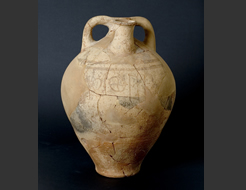|
||||||||||||||||||||||||||||||||
|
|
Museum of: Athens | |||||||||||||||||||||||||||||||
| Name of the artefact: Large stirrup jars with Linear B inscription | ||||||||||||||||||||||||||||||||
|
Clay wheel-made stirrup-jar bearing a Linear B
inscription. |
||||||||||||||||||||||||||||||||
|
WHERE IS IT AND MAIN
CHARACTERISTICS |
STATE |
|||||||||||||||||||||||||||||||
|
Department: |
Prehistoric |
Preservation: |
Good | |||||||||||||||||||||||||||||
|
Inventory number: |
7628 |
Restauration: |
Restored | |||||||||||||||||||||||||||||
|
Name of the artefact: |
Large stirrup jars with Linear B
inscription |
Completeness: |
Complete | |||||||||||||||||||||||||||||
|
Object type: |
Vessel/Anphora |
|||||||||||||||||||||||||||||||
|
Material: |
Clay |
|||||||||||||||||||||||||||||||
|
Methof of manufacture: |
Wheel-made |
|||||||||||||||||||||||||||||||
|
Decoration
type: |
Painting |
|||||||||||||||||||||||||||||||
|
Distinctive mark: |
Script |
|||||||||||||||||||||||||||||||
|
DIMENSIONS |
PERIOD OF USE |
|||||||||||||||||||||||||||||||
|
Length (mm): |
- |
Epoque: |
Late Bronge Age |
|||||||||||||||||||||||||||||
|
Heigth
(mm): |
425 |
Culture: |
Mycenaean |
|||||||||||||||||||||||||||||
|
Diameter
(mm): |
98 max - 115 min |
Period: |
Late Helladic |
|||||||||||||||||||||||||||||
|
Width (mm): |
- |
Face: |
LH IIIB- |
|||||||||||||||||||||||||||||
|
Thickness (mm): |
- |
Absolute chronology: |
13 century BC |
|||||||||||||||||||||||||||||
|
Weight
(g): |
- |
|||||||||||||||||||||||||||||||
DISCOVERY |
||||||||||||||||||||||||||||||||
|
Date: |
1952 |
Country: |
Greece |
|||||||||||||||||||||||||||||
|
District: |
Peloponnese |
Town hall affiliation: |
Nauplion |
|||||||||||||||||||||||||||||
|
Village: |
Mycenae |
Discovery findspot: |
Acropolis of Mycenae, area of the “poros
fortifica |
|||||||||||||||||||||||||||||
|
Condition of discovery: |
Archaeological excavation |
Discovery type: |
Deposit |
|||||||||||||||||||||||||||||
|
ANALYSES – DETERMINATIONS |
FILLED IN BY |
|||||||||||||||||||||||||||||||
|
Type: |
- |
Name: |
Alexandra Christopoulou |
|||||||||||||||||||||||||||||
|
Laboratory: |
- |
Institution: |
National Archaeological Museum -
Greece |
|||||||||||||||||||||||||||||
|
No./Code: |
- |
Date: |
22/11/2005 |
|||||||||||||||||||||||||||||
|
DEEPENINGS |
||||||||||||||||||||||||||||||||
|
Morphology of the object: |
||||||||||||||||||||||||||||||||
|
Clay wheel made stirrup-jar. The base is flat and
rather small to support the tall ovoid-conical body. The two heavy
vertical handles on the shoulder would be perfectly functionable to the
size as well as the content of this utensil. The spout has been made
off-centre on the shoulder and this peculiarity was most probably an
imitation from similar but smaller in size stirrup vases, which had the
same content, that is oil. |
||||||||||||||||||||||||||||||||
|
Decoration: |
||||||||||||||||||||||||||||||||
|
The vase has a simple linear decoration with pale red
colour onto the yellowish surfase. It consists of double horizontal bands
round the shoulder and another simple band at the lower body. |
||||||||||||||||||||||||||||||||
|
Inscription: |
||||||||||||||||||||||||||||||||
|
There is an inscription in the Linear B script on the
shoulder of the vase. The length of the inscription is 0,17 cm, the height
of each ideogramm been 0,07 cm. This inscription is constituted out of
five ideogramms. Its transliteration is: e-ra , ka-ta-ro. The meaning is
either“virgin oil”( which in the greek language is «έλαιο καθαρό»), or “to
Hera (the) pure”, i.e. to the Goddess Hera this pure (virgin oil) is
dedicated. |
||||||||||||||||||||||||||||||||
|
Analogies: |
||||||||||||||||||||||||||||||||
|
The Linear B is the mycenaean script deciphered by
Michael Ventris in 1950s. There is a good number of inscribed stirrup-jars
in all the mycenaean citadels of the greek mainland as well as in the
post-minoan palaces in Crete. There are also the clay tablets with linear
B script from the famous archives of the palace of Nestor (see object no
Ta 709-712) |
||||||||||||||||||||||||||||||||
|
Interpretation: |
||||||||||||||||||||||||||||||||
|
Petrographic analysis of a substancial number of
srirrup-jars from the mycenaean palace at Mycenae has shown, that a large
number of this type of vessels was imported from West Crete, possibly also
from the Knossos region. Mycenae in this period, 13th cent. BC., was an
active participant in the trade of oil or wine implied by the lively
traffic in stirrup-jars. Oil, perhaps perfumed, and wine, produced in
quantity in Crete were imported to mainland greek centres such as Mycenae,
and used locally or perhaps repackaged into stirrup-jars, inscribed this
time, for redistribution or re-export. |
||||||||||||||||||||||||||||||||
|
Bibliography: |
||||||||||||||||||||||||||||||||
|
- |
||||||||||||||||||||||||||||||||

